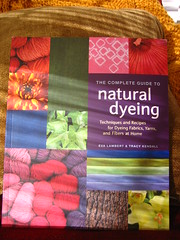First, the facts:
Title: Natural Dyeing: Techniques and Recipes for Dyeing Fabrics, Yarns, and Fibers at Home
Author: Eva Lambert & Tracy Kengall
Published by: Interweave Press, 2010
Pages: 143 pages
Type: Dyeing
Chapters:
1. Understanding the Basics
2. Collecting your own Dyestuffs
3. Dyeing Techniques
4. Recipes
For Yarns
For Fabrics
Pattern Size Range: N/A
First Reaction: So many beautiful colors!
The In-Depth Look:
I’ve never been all that interested in dyeing my own yarn. It seems so messy and time-consuming. And messy. Not to mention all the chemicals, and the difficulty finding someplace safe (that is, stain-resistant and away from the food) to experiment. Not to mention messy. It just seemed easier to let the experts deal with it.
Then this book came, filled with straight-forward instructions, great illustrations and oh, so many pretty pictures of colors … all possible with 100% natural dyes.
Since I haven’t dyed anything other than my (occasional, naturally) gray hairs, I’m obviously not an expert, but the explanations in this book seem clear and thorough to me. The author explains how dyes will set in different fibers, and why it is different from one to the next. She explains the need for a mordant–that final step that fixes the dye to keep it from washing away. She gives techniques on basic dyeing, but also what to do if you want something different, like tie-dye, or homemade batik. The explanations are simple throughout and make it all sound so easy.
The objective of the book is to dye with natural materials, not bottles of chemicals, and so she discusses the different types of dye sources–bark, flowers, leaves, seeds, insects, and so on–as well as giving tips on how to find and harvest these items yourself, rather than depending on a commercial source, at least for the plants that should be local to you.
The back-half of the book is filled with pretty, pretty pictures–photographs of dyed samples using specific dyes in specific ways. I had no idea what a different range of color you could get from the same dye source depending on the way it is handled, or the mordant that is used. The book is not an exhaustive resource of all possible dyes, mind you. There are some dyes that even I have heard of that weren’t mentioned, but that doesn’t make it any less valuable as a reference. The book is more about how to go about it, what to do, and why you should care than an attempt at an encyclopedic listing of every possible dyestuff.
We so often let ourselves be distanced from the source of things–where our food and clothing comes from is less understood all the time. When you’re used to buying your clothing off the rack in the store, you are about as far away from when the cotton boll was picked, or the wool was sheared as you can be. It’s easy to forget not only the many details that our ancestors sweated to learn, but also how real and immediate the manufacture used to be. Knitting and sewing bring you closer, but the difference between buying ready-to-knit yarn in your favorite color is a far cry from carding, spinning, and dyeing it yourself.
So many valuable nuggets of information are lost every day. (Did you know the first, best, true-red dye came from insects?) There are so many things my grandmother, great-grandmother, and so on knew to do but that have been forgotten by my generation, and this book is one way to claim some of them back again. With this book, if I had to, I could create my own green dye, or blue, or yellow, or red, without having to depend on anyone else to mix a batch of chemicals.
Am I going to run right out to try to find some madder root or birch tree bark to put this book in action? Well, no. It’s still winter and kind of cold out there. But this book makes me think that I MIGHT … and considering that I’ve never been interested in dyeing before? That says a lot.
This interesting and informative book can be bought at Amazon.com
Want to see bigger pictures? Click here.

Click here to see the key for the icons.



Comments on this entry are closed.
Dyeing can be messy. So far, I have only used food coloring so that it is kitchen safe and I hesitate to use chemicals which means finding some place else with heat and water to dye, however, even using natural materials to dye doesn’t necessarily mean it is safer: some of the mordants are very toxic and must be handled with care.
Exactly. Not only that, up until a few months ago, our kitchen sink was white Corian that stained when you looked at it sideways. Dyeing was NOT an option! (grin)